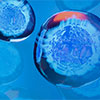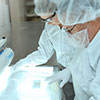chromatography+columns+HyClone+products+(Cytiva)
Catalog Number:
(10110-556)
Supplier:
Prosci
Description:
The structure of MAS1 indicates that it belongs to the class of receptors that are coupled to GTP-binding proteins and share a conserved structural motif, which is described as a '7-transmembrane segment' following the prediction that these hydrophobic segments form membrane-spanning alpha-helices. The MAS1 protein may be a receptor that, when activated, modulates a critical component in a growth-regulating pathway to bring about oncogenic effects.The structure of the MAS1 product indicates that it belongs to the class of receptors that are coupled to GTP-binding proteins and share a conserved structural motif, which is described as a '7-transmembrane segment' following the prediction that these hydrophobic segments form membrane-spanning alpha-helices. The MAS1 protein may be a receptor that, when activated, modulates a critical component in a growth-regulating pathway to bring about oncogenic effects.The structure of the MAS1 product indicates that it belongs to the class of receptors that are coupled to GTP-binding proteins and share a conserved structural motif, which is described as a '7-transmembrane segment' following the prediction that these hydrophobic segments form membrane-spanning alpha-helices. The MAS1 protein may be a receptor that, when activated, modulates a critical component in a growth-regulating pathway to bring about oncogenic effects.
Catalog Number:
(10108-930)
Supplier:
Prosci
Description:
Alzheimer's disease (AD) patients with an inherited form of the disease carry mutations in the presenilin proteins (PSEN1 or PSEN2) or the amyloid precursor protein (APP). These disease-linked mutations result in increased production of the longer form of amyloid-beta (main component of amyloid deposits found in AD brains). Presenilins are postulated to regulate APP processing through their effects on gamma-secretase, an enzyme that cleaves APP. Also, it is thought that the presenilins are involved in the cleavage of the Notch receptor such that, they either directly regulate gamma-secretase activity, or themselves act are protease enzymes.Alzheimer's disease (AD) patients with an inherited form of the disease carry mutations in the presenilin proteins (PSEN1; PSEN2) or the amyloid precursor protein (APP). These disease-linked mutations result in increased production of the longer form of amyloid-beta (main component of amyloid deposits found in AD brains). Presenilins are postulated to regulate APP processing through their effects on gamma-secretase, an enzyme that cleaves APP. Also, it is thought that the presenilins are involved in the cleavage of the Notch receptor, such that that they either directly regulate gamma-secretase activity or themselves are protease enzymes. Two alternative transcripts of PSEN2 have been identified.
Catalog Number:
(10101-838)
Supplier:
Prosci
Description:
SSX4 belongs to the SSX family. It contains 1 KRAB-related domain.SSX4 could act as a modulator of transcription. The product of this gene belongs to the family of highly homologous synovial sarcoma X (SSX) breakpoint proteins. These proteins may function as transcriptional repressors. They are also capable of eliciting spontaneously humoral and cellular immune responses in cancer patients, and are potentially useful targets in cancer vaccine-based immunotherapy. SSX1, SSX2 and SSX4 genes have been involved in the t (X;18) translocation characteristically found in all synovial sarcomas. This translocation results in the fusion of the synovial sarcoma translocation gene on chromosome 18 to one of the SSX genes on chromosome X. Chromosome Xp11 contains a segmental duplication resulting in two identical copies of synovial sarcoma, X breakpoint 4, SSX4 and SSX4B, in tail-to-tail orientation. This gene, SSX4, represents the more telomeric copy. Two transcript variants encoding distinct isoforms have been identified for this gene.
Catalog Number:
(89358-520)
Supplier:
Genetex
Description:
This gene belongs to the Ras oncogene family, whose members are related to the transforming genes of mammalian sarcoma retroviruses. The products encoded by these genes function in signal transduction pathways. These proteins can bind GTP and GDP, and they have intrinsic GTPase activity. This protein undergoes a continuous cycle of de- and re-palmitoylation, which regulates its rapid exchange between the plasma membrane and the Golgi apparatus. Mutations in this gene cause Costello syndrome, a disease characterized by increased growth at the prenatal stage, growth deficiency at the postnatal stage, predisposition to tumor formation, mental retardation, skin and musculoskeletal abnormalities, distinctive facial appearance and cardiovascular abnormalities. Defects in this gene are implicated in a variety of cancers, including bladder cancer, follicular thyroid cancer, and oral squamous cell carcinoma. Multiple transcript variants, which encode different isoforms, have been identified for this gene. [provided by RefSeq]
Catalog Number:
(10108-502)
Supplier:
Prosci
Description:
WNT proteins are secreted signaling proteins. These proteins have been implicated in oncogenesis and in several developmental processes, including regulation of cell fate and patterning during embryogenesis. WNT16 contains two transcript variants diverging at the 5' termini. These two variants are proposed to be the products of separate promoters and not to be splice variants from a single promoter. They are differentially expressed in normal tissues, one of which (variant 2) is expressed at significant levels only in the pancreas, whereas another one (variant 1) is expressed more ubiquitously with highest levels in adult kidney, placenta, brain, heart, and spleen.The WNT gene family consists of structurally related genes which encode secreted signaling proteins. These proteins have been implicated in oncogenesis and in several developmental processes, including regulation of cell fate and patterning during embryogenesis. This gene is a member of the WNT gene family. It contains two transcript variants diverging at the 5' termini. These two variants are proposed to be the products of separate promoters and not to be splice variants from a single promoter. They are differentially expressed in normal tissues, one of which (variant 2) is expressed at significant levels only in the pancreas, whereas another one (variant 1) is expressed more ubiquitously with highest levels in adult kidney, placenta, brain, heart, and spleen.
Catalog Number:
(10102-498)
Supplier:
Prosci
Description:
Albumin is a soluble, monomeric protein which comprises about one-half of the blood serum protein. Albumin functions primarily as a carrier protein for steroids, fatty acids, and thyroid hormones and plays a role in stabilizing extracellular fluid volume. Albumin is a globular unglycosylated serum protein of molecular weight 65,000. Albumin is synthesized in the liver as preproalbumin which has an N-terminal peptide that is removed before the nascent protein is released from the rough endoplasmic reticulum. The product, proalbumin, is in turn cleaved in the Golgi vesicles to produce the secreted albumin.Albumin is a soluble, monomeric protein which comprises about one-half of the blood serum protein. Albumin functions primarily as a carrier protein for steroids, fatty acids, and thyroid hormones and plays a role in stabilizing extracellular fluid volume. Albumin is a globular unglycosylated serum protein of molecular weight 65,000. Albumin is synthesized in the liver as preproalbumin which has an N-terminal peptide that is removed before the nascent protein is released from the rough endoplasmic reticulum. The product, proalbumin, is in turn cleaved in the Golgi vesicles to produce the secreted albumin. Publication Note: This RefSeq record includes a subset of the publications that are available for this gene. Please see the Entrez Gene record to access additional publications.
Catalog Number:
(10104-158)
Supplier:
Prosci
Description:
ARF6 is a member of the human ARF family, which is part of the RAS superfamily. They are small guanine nucleotide-binding proteins that stimulate the ADP-ribosyltransferase activity of cholera toxin and play a role in vesicular trafficking and as activators of phospholipase D. ARF6 is localized to the plasma membrane, and regulates vesicular trafficking, remodelling of membrane lipids, and signaling pathways that lead to actin remodeling. This gene encodes a member of the human ARF gene family, which is part of the RAS superfamily. The ARF genes encode small guanine nucleotide-binding proteins that stimulate the ADP-ribosyltransferase activity of cholera toxin and play a role in vesicular trafficking and as activators of phospholipase D. The product of this gene is localized to the plasma membrane, and regulates vesicular trafficking, remodelling of membrane lipids, and signaling pathways that lead to actin remodeling. A pseudogene of this gene is located on chromosome 7. Publication Note: This RefSeq record includes a subset of the publications that are available for this gene. Please see the Entrez Gene record to access additional publications.
Catalog Number:
(89358-282)
Supplier:
Genetex
Description:
This gene encodes a protein that has been identified as a component of NuRD, a nucleosome remodeling deacetylase complex identified in the nucleus of human cells. It shows a very broad expression pattern and is strongly expressed in many tissues. It may represent one member of a small gene family that encode different but related proteins involved either directly or indirectly in transcriptional regulation. Their indirect effects on transcriptional regulation may include chromatin remodeling. It is closely related to another member of this family, a protein that has been correlated with the metastatic potential of certain carcinomas. These two proteins are so closely related that they share the same types of domains. These domains include two DNA binding domains, a dimerization domain, and a domain commonly found in proteins that methylate DNA. One of the proteins known to be a target protein for this gene product is p53. Deacteylation of p53 is correlated with a loss of growth inhibition in transformed cells supporting a connection between these gene family members and metastasis. [provided by RefSeq]
Supplier:
G-Biosciences
Description:
G-Biosciences' Nickel Chelating Resin is an immobilized metal affinity chromatography (IMAC) resin that was specifically designed to utilize Ni²⁺ for the purification of nickel binding proteins, including 6x histidine tagged proteins.
Catalog Number:
(10111-318)
Supplier:
Prosci
Description:
ETV6 (ETS-related protein Tel1, ETS translocation variant 6 , Tel) is an ETS family transcription factor. This protein contains two functional domains: a N-terminal pointed (PNT) domain that is involved in the protein-protein interactions with itself and other proteins, and a C-terminal DNA-binding domain. Gene knockout studies in mice suggest that it is required for hematopoiesis and maintenance of the developing vascular network. This gene is known to be involved in a large number of chromosomal rearrangements associated with leukemia and congenital fibrosarcoma.This gene encodes an ETS family transcription factor. The product of this gene contains two functional domains: a N-terminal pointed (PNT) domain that is involved in the protein-protein interactions with itself and other proteins, and a C-terminal DNA-binding domain. Gene knockout studies in mice suggest that it is required for hematopoiesis and maintenance of the developing vascular network. This gene is known to be involved in a large number of chromosomal rearrangements associated with leukemia and congenital fibrosarcoma.
Catalog Number:
(10102-306)
Supplier:
Prosci
Description:
Oxysterols regulate cholesterol homeostasis through the liver X receptor (LXR)- and sterol regulatory element-binding protein (SREBP)-mediated signaling pathways. This gene is an insulin-induced gene. INSIG1 is an endoplasmic reticulum (ER) membrane protein that plays a critical role in regulating cholesterol concentrations in cells. INSIG1 binds to the sterol-sensing domains of SREBP cleavage-activating protein (SCAP) and HMG CoA reductase, and is essential for the sterol-mediated trafficking of the two proteins.The protein encoded by this gene is highly similar to the protein product encoded by gene INSIG1. Both INSIG1 protein and this protein are endoplasmic reticulum proteins that block the processing of sterol regulatory element binding proteins (SREBPs) by binding to SREBP cleavage-activating protein (SCAP), and thus prevent SCAP from escorting SREBPs to the Golgi. Publication Note: This RefSeq record includes a subset of the publications that are available for this gene. Please see the Entrez Gene record to access additional publications.
Catalog Number:
(10101-592)
Supplier:
Prosci
Description:
TEAD4 is a member of the transcriptional enhancer factor (TEF) family of transcription factors, which contain the TEA/ATTS DNA-binding domain. TEAD4 is preferentially expressed in the skeletal muscle, and binds to the M-CAT regulatory element found in promoters of muscle-specific genes to direct their gene expression. Alternatively spliced transcripts encoding distinct isoforms, some of which are translated through the use of a non-AUG (UUG) initiation codon, have been described for this protein.This gene product is a member of the transcriptional enhancer factor (TEF) family of transcription factors, which contain the TEA/ATTS DNA-binding domain. It is preferentially expressed in the skeletal muscle, and binds to the M-CAT regulatory element found in promoters of muscle-specific genes to direct their gene expression. Alternatively spliced transcripts encoding distinct isoforms, some of which are translated through the use of a non-AUG (UUG) initiation codon, have been described for this gene.
Catalog Number:
(10108-686)
Supplier:
Prosci
Description:
CHGA is a member of the chromogranin/secretogranin family of neuroendocrine secretory proteins. It is found in secretory vesicles of neurons and endocrine cells. Its gene's product is a precursor to three biologically active peptides; vasostatin, pancreastatin, and parastatin. These peptides act as autocrine or paracrine negative modulators of the neuroendocrine system. Other peptides, including chromostatin, beta-granin, WE-14 and GE-25, are also derived from the full-length protein. However, biological activities for these molecules have not been shown.The protein encoded by this gene is a member of the chromogranin/secretogranin family of neuroendocrine secretory proteins. It is found in secretory vesicles of neurons and endocrine cells. This gene product is a precursor to three biologically active peptides; vasostatin, pancreastatin, and parastatin. These peptides act as autocrine or paracrine negative modulators of the neuroendocrine system. Other peptides, including chromostatin, beta-granin, WE-14 and GE-25, are also derived from the full-length protein. However, biological activities for these molecules have not been shown.The protein encoded by this gene is a member of the chromogranin/secretogranin family of neuroendocrine secretory proteins. It is found in secretory vesicles of neurons and endocrine cells. This gene product is a precursor to three biologically active peptides; vasostatin, pancreastatin, and parastatin. These peptides act as autocrine or paracrine negative modulators of the neuroendocrine system. Other peptides, including chromostatin, beta-granin, WE-14 and GE-25, are also derived from the full-length protein. However, biological activities for these molecules have not been shown.
Catalog Number:
(10108-608)
Supplier:
Prosci
Description:
CHST7 belongs to the sulfotransferase family. Sulfotransferases generate sulfated glycosaminoglycan (GAG) moities during chondroitin sulfate biosynthesis. They create considerable structural diversity among chondroitin sulfates by transferring sulfate with remarkable specificity for the underlying oligosaccharide substrate. This protein mainly transfers sulfate to N-acetylgalactosamine. The regulated expression of each member of the family may be an important determinant of sulfated GAGs expression and the associated function of chondroitin sulfates as regulators of many biologic processes.This gene belongs to the sulfotransferase gene family. Sulfotransferases generate sulfated glycosaminoglycan (GAG) moities during chondroitin sulfate biosynthesis. They create considerable structural diversity among chondroitin sulfates by transferring sulfate with remarkable specificity for the underlying oligosaccharide substrate. This gene product mainly transfers sulfate to N-acetylgalactosamine. The regulated expression of each member of this gene family may be an important determinant of sulfated GAGs expression and the associated function of chondroitin sulfates as regulators of many biologic processes. This gene is part of a gene cluster on chromosome Xp11.23.
Supplier:
AVANTOR PERFORMANCE MATERIAL LLC
Description:
Avantor excipients are used during the formulation process in a wide range of applications. Avantor provides high-purity and performance excipients that serve as fillers, binders, disintegrants, lubicants, flavors, emulsifiers and preservatives. All the products are cGMP produced and meet USP grade standards.
Catalog Number:
(10099-852)
Supplier:
Prosci
Description:
PDSS1 is an enzyme that elongates the prenyl side-chain of coenzyme Q, or ubiquinone, one of the key elements in the respiratory chain. PDSS1 catalyzes the formation of all trans-polyprenyl pyrophosphates from isopentyl diphosphate in the assembly of polyisoprenoid side chains, the first step in coenzyme Q biosynthesis. The protein may be peripherally associated with the inner mitochondrial membrane, though no transit peptide has been definitively identified to date. Defects in PDSS1 gene are a cause of coenzyme Q10 deficiency.The protein encoded by this gene is an enzyme that elongates the prenyl side-chain of coenzyme Q, or ubiquinone, one of the key elements in the respiratory chain. The gene product catalyzes the formation of all trans-polyprenyl pyrophosphates from isopentyl diphosphate in the assembly of polyisoprenoid side chains, the first step in coenzyme Q biosynthesis. The protein may be peripherally associated with the inner mitochondrial membrane, though no transit peptide has been definitively identified to date. Defects in this gene are a cause of coenzyme Q10 deficiency.
Inquire for Price
Stock for this item is limited, but may be available in a warehouse close to you. Please make sure that you are logged in to the site so that available stock can be displayed. If the
Stock for this item is limited, but may be available in a warehouse close to you. Please make sure that you are logged in to the site so that available stock can be displayed. If the
You must log in to order restricted items. We request that you provide the required business documentation to purchase this product for the first time.
To order chemicals, medical devices, or other restricted products please provide identification that includes your business name and shipping address via email CMD_NA@vwr.com or fax 484.881.5997 referencing your VWR account number . Acceptable forms of identification are:
-Additional Documentation May be needed to purchase this item. A VWR representative will contact you if needed.
This product has been blocked by your organization. Please contact your purchasing department for more information.
The original product is no longer available. The replacement shown is available.
This product is currently unavailable but limited stock may be available in our extended warehouse network. Please call 1-800-932-5000 and a VWR Customer Service Representative will help you.
|
|||||||||


































